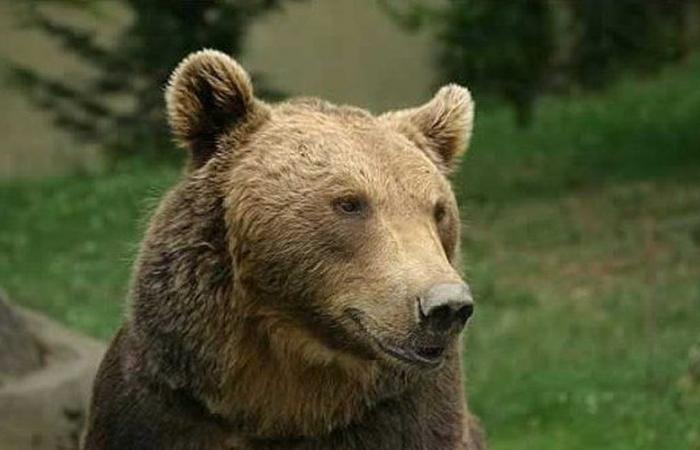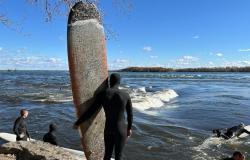the essential
It was a turning point in the great history of the presence of the bear in the Pyrenees: on November 1, 2004, the bear Cannelle was killed by a hunter during a wild boar hunt, in the Pyrénées-Atlantiques. The tragedy was considered a real ecological disaster because she was the last female of Pyrenean stock. A look back at a death that shocked France.
Between the walls of the Natural History Museum of Toulouse (Haute-Garonne), the remains of the animal sit in the middle of the corridors. It has been a few months since the bear Cannelle returned to the establishment, recalling the difficult memory of November 1, 2004. It was on this date that above Urdos (Pyrénées-Atlantiques), in the Aspe valley, the last bear of Pyrenean stock was killed during a wild boar hunt. At the time, the death of the 12-year-old female was considered a true ecological disaster.
The 1st November 2004it was René Marquèze, a hunter, who fired the fatal shot. The plantigrade finished its race 250 meters lower. An investigation is opened: the Béarnais was then far from suspecting that the death of the bear would turn a new page in the presence of the mammal in the Pyrenees, at the cost of many years of divisions and a fierce legal marathon.
“It was the bear or me”
The first elements of the investigation do not work in favor of the hunter. Naturalists who were part of the Ecopastoral Intervention Fund (FIEP) – a structure responsible for monitoring bears in the Pyrenees – had in fact indicated, two days before the hunt, that traces of fresh excrement belonging to the bear and her little one aged 10 months, had been unearthed on the heights of Urdos. A report had been made on the “Brown Bear” network: the Urdos hunting company was therefore fully aware of the presence of the plantigrade in the area. Facing investigators, René Marquèze highlighted the particularly aggressive behavior of the bear during their encounter, claiming that the female had bitten one of his dogs.
Also read:
“We cannot both defend its presence in the Pyrenees and harass it”: the cause of the bears comes down from the mountain and comes to the court of Toulouse
Faced with emotion, the government reacted quickly. Serge Lepeltier, then Minister of Ecology and Sustainable Development, announced in January 2005 the implementation of a bear reintroduction plan in the Pyrenees.
At the same time, René Marquèze's legal marathon begins. In mars 2008the Béarnais is summoned before the criminal court of Pau (Pyrénées-Atlantiques): accused of “destruction of a protected species”, the judgment takes on the appearance of an assize trial. At the helm, the hunter defends himself: “It was the bear or me,” he says. The investigating judge, Frédérique Loubet, then acquitted René Marquèze, ruling out any “intentional” aspect, causing the consternation of the civil parties.
More than 10,000 euros in damages
And then the big turnaround: September 2009the Pau Court of Appeal went against the decision of the criminal court, finding that the Béarnais was “entirely responsible for the death of the bear Cannelle”. René Marquèze is ordered to pay 11,000 euros in damages to seven different associations as well as 3,500 euros in legal costs. In its judgment, the Pau Court of Appeal considers that “the group of hunters, and therefore René Marquèze, knew from the start of the hunt that he was likely to encounter the bear Cannelle and her cub in the hunting area But, despite this, the hunters decided to continue the hunt.
DDM
It is the Court of Cassation which will ultimately decide: In June 2010René Marquèze is ordered to pay more than 10,000 euros to environmental defense associations… but will not be recognized as responsible for the death of the bear on the criminal aspect.
In addition to the question of the responsibility of the hunter, it is that of the Urdos hunting society, informed of the presence of the plantigrade in the area, which is raised. The WWF (World Wide Fund for Nature) – a non-governmental organization – has grasped this question very well. A legal procedure had been set up in parallel since 2005, before the civil chamber of the Pau high court: in 2013the hunting hunting company was finally ordered to pay 50,000 euros in damages to the WWF, but it is protected by its insurer: no hunter will have to pay out a single cent. Decision was made not to appeal.
DDM – NATHALIE SAINT-AFFRE
Cannelle's remains were finally naturalized by knowledgeable preparers, within the Museum of Toulouse. The bear was finally revealed to the general public in 2013.







